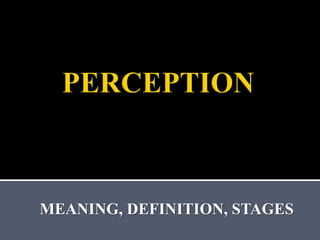
perception- Meaning, Definition, Stages, Factors
- 2. “ WE DON’T SEE THINGS AS THEY ARE, WE SEE THINGS AS WE ARE.”
- 3. Perception is the process of organizing and interpretation of sensory data in terms of one’s previous experience and present needs. Perception is the sensory experience of the world. It involves both recognizing environmental stimuli and actions in response to these stimuli. Through the perceptual process, we gain information about the properties and elements of the environment that are critical to our survival.
- 4. The process by which people select, organize, interpret, retrieve, and respond to information. Perceptions differ from person to person. Each individual perceives the same situation differently. Individuals organize and interpret things based on their past experiences and the important values they consider important. Employees tend to behave and act on certain things on the basis of their perception.
- 6. STEPHEN ROBBINS “ Perception is a process by which individual’s organize and interpret the sensory impressions in order to give meaning to their environment.” FRED LUTHANS “Perception is an important mediating cognitive process through which persons make interpretations of the stimulus or situation they are forced with.” In general, it can be defined as “ a process that involves seeing, receiving, selecting, organizing, interpreting and giving meaning to the environment”.
- 7. 1. Perception is the process by which an individual gives meaning to the environment. 2. It is a cognitive and psychological process. 3. People’s action, emotions, thoughts and feelings are triggered by their perceptions. 4. Since perception refers to the acquisition of specific knowledge about objects or events at any particular moment, it occurs whenever stimuli activate the sense organs.
- 8. 5. Though perception has been defined in a variety of ways, it basically refers to the manner in which a person experiences the world. 6. Perception is an almost automatic process and works in much the same way within each individual, yet typically yields different perceptions. 7. A stimulus that is not perceived has no effect on behavior. 8.Perception is a process that operates constantly between us and reality.
- 9. 9.Since perception is subjective process, different people may perceive the same environment differently. So perception is like beauty, that lies in the eyes of the beholder. 10. Perception involves the creation of gestalts. 11.Perception is a unique interpretation of the situation, not an exact recording of the situation. 12.Perception is more complex and much broader than sensation.
- 10. Perception plays a very important role in shaping the personality of an individual. Perception is central in interpreting the world around us. Perception affects the outcome of our behavior because we act on the basis of what we see. Managers should be able to distinguish between a perceived world and the reality. An understanding of perception is important to understand and control the human behavior .
- 11. Characteristics of the perceiver. Characteristics of the setting. Characteristics of the perceived.
- 12. Characteristics of the perceiver. The perceptual process is influenced by the perceiver’s: •Past experiences. •Needs or motives. •Personality. •Values and attitudes. Characteristics of the setting. The perceptual process is influenced by the setting’s: •Physical context. •Social context. •Organizational context. FACTORS……….
- 13. Characteristics of the perceived. The perceptual process is influenced by characteristics of the perceived person, object, or event, such as: •Contrast. •Intensity. •Figure-ground separation. •Size. •Motion. •Repetition or novelty. FACTORS……….
- 14. Factors in the perceiver Attitudes Motives Interests Experience Expectations Perception Factors in the perceived Motion Sounds Size Background Proximity Similarity Factors in the situation Time Work Setting Social Setting
- 15. Perceptual throughputs Receiving->Selecting->Organizing->Interpreting Perceptual Outputs Actions Perceptual inputs Stimuli Simplified process of perception
- 17. The different stages involved in perception are: 1. Sensation/Stimulation: It is meaningful awareness of object 2. Attention: perceptual readiness (the process of focusing upon certain phases or elements of experience and neglecting others) 3. Understanding: the meaning of object and what the object is 4. Relating to past experience: Relating the object to past experience and present needs for comprehensive usefulness of the object to give meaning 5. Cognition: Interpreting and perceiving the object
- 18. Stereotypes or prototypes. Halo effects. Selective perception. Projection. Contrast effects. Self-fulfilling prophecy.
- 19. Stereotypes or prototypes. Combines information based on the category or class to which a person, situation, or object belongs Halo effects Occur when one attribute of a person or situation is used to develop an overall impression of the individual or situation.
- 21. Selective perception. The tendency to single out those aspects of a situation, person, or object that are consistent with one’s needs, values, or attitudes. Projection. The assignment of one’s personal attributes to other individuals. Projection can be controlled through a high degree of self-awareness and empathy.
- 23. Contrast effects. Occur when an individual is compared to other people on the same characteristics on which the others rank higher or lower. Self-fulfilling prophecy. The tendency to create or find in another situation or individual that which one expected to find. Managers should adopt positive and optimistic approaches to people at work.
- 25. Impression management. A person’s systematic attempt to behave in ways that create and maintain desired impressions in others’ eyes. Successful managers: Use impression management to enhance their own images. Are sensitive to other people’s use of impression management.
- 26. Distortion management. Managers should: Balance automatic and controlled information processing at the attention and selection stage. Broaden their schemas at the organizing stage. Be attuned to attributions at the interpretation stage.